Long-Range Imaging of Alpha Emitters Using Radioluminescence in Open Environments: Daytime and Night-Time Applications
Abstract
:1. Introduction
2. Materials and Methods
2.1. Alpha Sources
2.2. Detection System
Camera
2.3. Filter Selection
2.3.1. Filter System for Night-Time Imaging
2.3.2. Filter System for Daytime Imaging
2.3.3. Optical Configuration
2.3.4. Power Supply
2.3.5. Artificial Light Source
2.4. Image Acquisition and Processing
3. Results and Discussion
3.1. Imaging of Alpha Source at Night-Time
3.2. Imaging of Alpha Source at Daytime
4. Conclusions
Author Contributions
Funding
Institutional Review Board Statement
Informed Consent Statement
Data Availability Statement
Acknowledgments
Conflicts of Interest
Abbreviations
| RL | Radioluminescence |
| PMT | Photomultiplier tube |
| CCD | Charge-coupled device |
| CWL | Center Wavelength |
| FWHM | Full Width at Half Maximum |
| OD | Optical Density |
| FL | Focal Length |
| EFL | Effective Focal Length |
| UV | Ultraviolet |
References
- Knoll, G.F. Radiation Detection and Measurement; John Wiley & Sons: Hoboken, NJ, USA, 2010. [Google Scholar]
- Loucas, B.D.; Durante, M.; Bailey, S.M.; Cornforth, M.N. Chromosome damage in human cells by γ rays, α particles and heavy ions: Track interactions in basic dose-response relationships. Radiat. Res. 2013, 179, 9–20. [Google Scholar] [CrossRef]
- Sawant, S.; Randers-Pehrson, G.; Geard, C.; Brenner and, D.; Hall, E. The bystander effect in radiation oncogenesis: I. Transformation in C3H 10T1/2 cells in vitro can be initiated in the unirradiated neighbors of irradiated cells. Radiat. Res. 2001, 155, 397–401. [Google Scholar] [CrossRef]
- Harrison, J.; Fell, T.; Leggett, R.; Lloyd, D.; Puncher, M.; Youngman, M. The polonium-210 poisoning of Mr Alexander Litvinenko. J. Radiol. Prot. 2017, 37, 266. [Google Scholar] [CrossRef]
- Gamma Rarely Accompanies Alpha Decays. Available online: https://radioactivity.eu.com/articles/phenomenon/alpha_gamma (accessed on 31 July 2023).
- Terada, K.; Nakamura, S.; Nakao, T.; Kimura, A.; Iwamoto, O.; Harada, H.; Takamiya, K.; Hori, J.I. Measurements of gamma-ray emission probabilities of 241, 243Am and 239Np. J. Nucl. Sci. Technol. 2016, 53, 1881–1888. [Google Scholar] [CrossRef]
- Ihantola, S.; Sand, J.; Peräjärvi, K.; Toivonen, J.; Toivonen, H. Principles of UV–gamma coincidence spectrometry. Nucl. Instrum. Methods Phys. Res. Sect. A Accel. Spectrometers Detect. Assoc. Equip. 2012, 690, 79–84. [Google Scholar] [CrossRef]
- Inrig, E.; Koslowsky, V.; Andrews, B.; Dick, M.; Forget, P.; Ing, H.; Hugron, R.; Wong, L. Development and testing of an air fluorescence imaging system for the detection of radiological contamination. In AIP Conference Proceedings; American Institute of Physics: College Park, MD, USA, 2011; Volume 1412, pp. 393–400. [Google Scholar]
- Klose, A.; Luchkov, M.; Dangendorf, V.; Krasniqi, F.; Lehnert, A.; Walther, C. On the way to remote sensing of alpha radiation: Radioluminescence of pitchblende samples. J. Radioanal. Nucl. Chem. 2022, 331, 5401–5410. [Google Scholar] [CrossRef]
- Kume, N.; Sumita, A.; Sakamoto, N.; Hoshi, T.; Okazaki, K.; Miyadera, H.; Miyahara, Y.; Nakai, Y. Alpha emitter detection systems using a UV light detector. Appl. Opt. 2022, 61, 1414–1419. [Google Scholar] [CrossRef]
- Li, N.; Zhang, N. Remote detection of alpha radiation source by optical method. Optoelectron. Lett. 2023, 19, 405–409. [Google Scholar] [CrossRef]
- Luchkov, M.; Dangendorf, V.; Giesen, U.; Langner, F.; Olaru, C.; Zadehrafi, M.; Klose, A.; Kalmankoski, K.; Sand, J.; Ihantola, S.; et al. Novel optical technologies for emergency preparedness and response: Mapping contaminations with alpha-emitting radionuclides. Nucl. Instrum. Methods Phys. Res. Sect. A Accel. Spectrometers Detect. Assoc. Equip. 2023, 1047, 167895. [Google Scholar] [CrossRef]
- Sand, J.; Nicholl, A.; Hrnecek, E.; Toivonen, H.; Toivonen, J.; Peräjärvi, K. Stand-off radioluminescence mapping of alpha emitters under bright lighting. IEEE Trans. Nucl. Sci. 2016, 63, 1777–1783. [Google Scholar] [CrossRef]
- Crompton, A.J.; Gamage, K.A.; Bell, S.; Wilson, A.P.; Jenkins, A.; Trivedi, D. First Results of Using a UVTron Flame Sensor to Detect Alpha-Induced Air Fluorescence in the UVC Wavelength Range. Sensors 2017, 17, 2756. [Google Scholar] [CrossRef]
- Baschenko, S.M. Remote optical detection of alpha particle sources. J. Radiol. Prot. 2004, 24, 75. [Google Scholar] [CrossRef]
- Chichester, D.L.; Watson, S.M. Multispectral UV-visual imaging as a tool for locating and assessing ionizing radiation in air. IEEE Trans. Nucl. Sci. 2011, 58, 2512–2518. [Google Scholar] [CrossRef]
- Feener, J.S.; Charlton, W.S. Preliminary results of nuclear fluorescence imaging of alpha and beta emitting sources. In Proceedings of the 2013 3rd International Conference on Advancements in Nuclear Instrumentation, Measurement Methods and their Applications (ANIMMA), Marseille, France, 23–27 June 2013; IEEE: Piscataway, NJ, USA, 2013; pp. 1–8. [Google Scholar]
- Kerst, T.; Sand, J.; Ihantola, S.; Peräjärvi, K.; Nicholl, A.; Hrnecek, E.; Toivonen, H.; Toivonen, J. Standoff alpha radiation detection for hot cell imaging and crime scene investigation. Opt. Rev. 2018, 25, 429–436. [Google Scholar] [CrossRef]
- Krasniqi, F.S.; Kerst, T.; Leino, M.; Eisheh, J.T.; Toivonen, H.; Röttger, A.; Toivonen, J. Standoff UV-C imaging of alpha particle emitters. Nucl. Instrum. Methods Phys. Res. Sect. A Accel. Spectrometers Detect. Assoc. Equip. 2021, 987, 164821. [Google Scholar] [CrossRef]
- Sand, J.; Ihantola, S.; Peräjärvi, K.; Nicholl, A.; Hrnecek, E.; Toivonen, H.; Toivonen, J. Imaging of alpha emitters in a field environment. Nucl. Instrum. Methods Phys. Res. Sect. A Accel. Spectrometers Detect. Assoc. Equip. 2015, 782, 13–19. [Google Scholar] [CrossRef]
- Crompton, A.J. Stand-Off Detection of Alpha-Induced Air-Radioluminescence Even under Daylight Conditions; Lancaster University: Lancaster, UK, 2019. [Google Scholar]
- Dandl, T.; Heindl, T.; Ulrich, A. Fluorescence of nitrogen and air. J. Instrum. 2012, 7, P11005. [Google Scholar] [CrossRef]
- Kong, L.; Scott, T.B.; Day, J.C.C.; Megson-Smith, D.A. Advancements in Remote Alpha Radiation Detection: Alpha-Induced Radio-Luminescence Imaging with Enhanced Ambient Light Suppression. Sensors 2024, 24, 3781. [Google Scholar] [CrossRef]
- Wu, Z.; Cheng, J.; Xu, M.; Wang, B.; Wang, Q.; Yu, A.; Zhang, Y.; Wen, W.; Wu, Y. The physical mechanism of alpha-particle-air interaction and analysis of long-range secondary particles yield. Radiat. Phys. Chem. 2023, 202, 110426. [Google Scholar] [CrossRef]
- Crompton, A.J.; Gamage, K.A.; Jenkins, A.; Taylor, C.J. Alpha particle detection using alpha-induced air radioluminescence: A review and future prospects for preliminary radiological characterisation for nuclear facilities decommissioning. Sensors 2018, 18, 1015. [Google Scholar] [CrossRef]
- Hecht, E. Optics; Pearson Education: Chennai, India, 2012. [Google Scholar]
- Thompson, C.; Barritt, E.; Shenton-Taylor, C. Predicting the air fluorescence yield of radioactive sources. Radiat. Meas. 2016, 88, 48–54. [Google Scholar] [CrossRef]



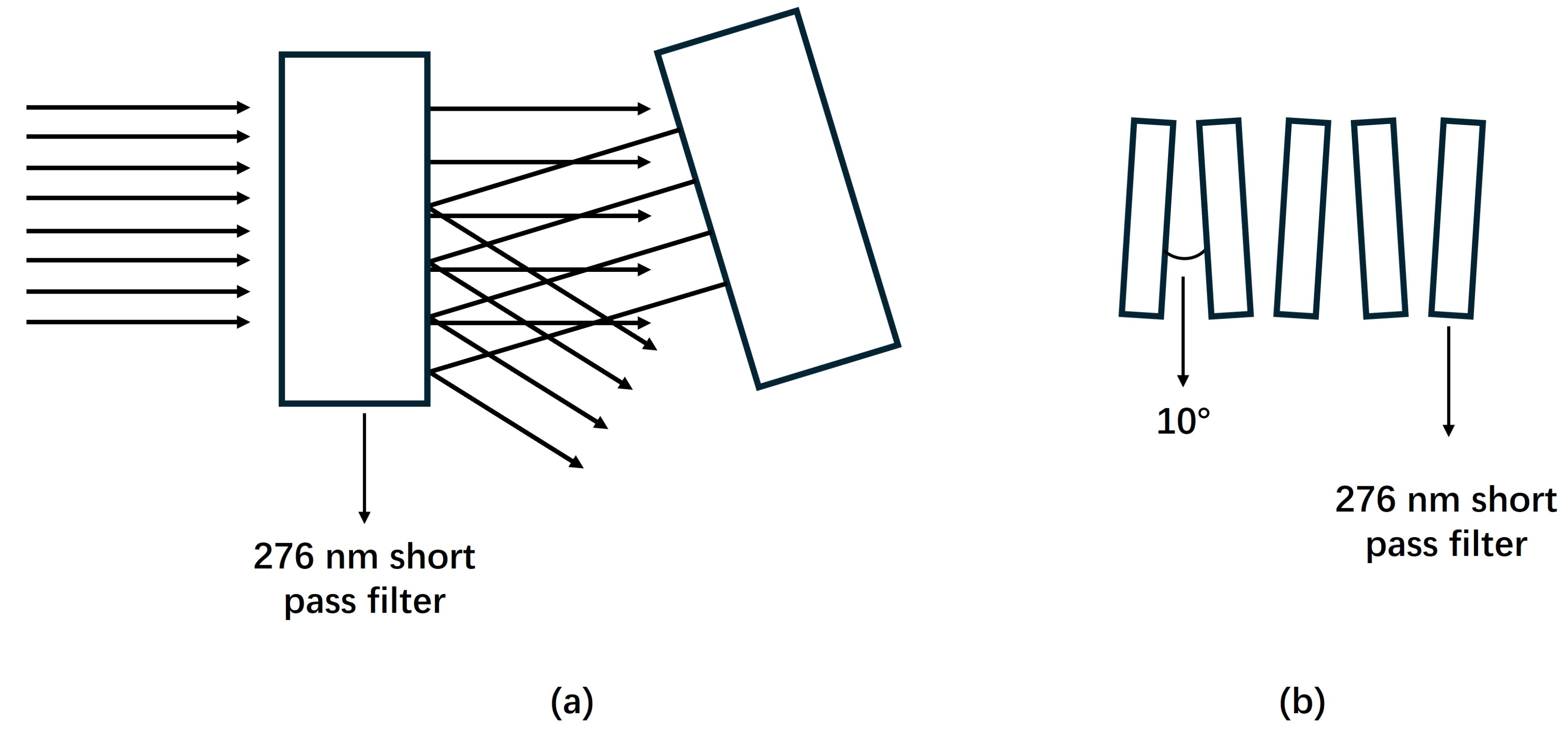


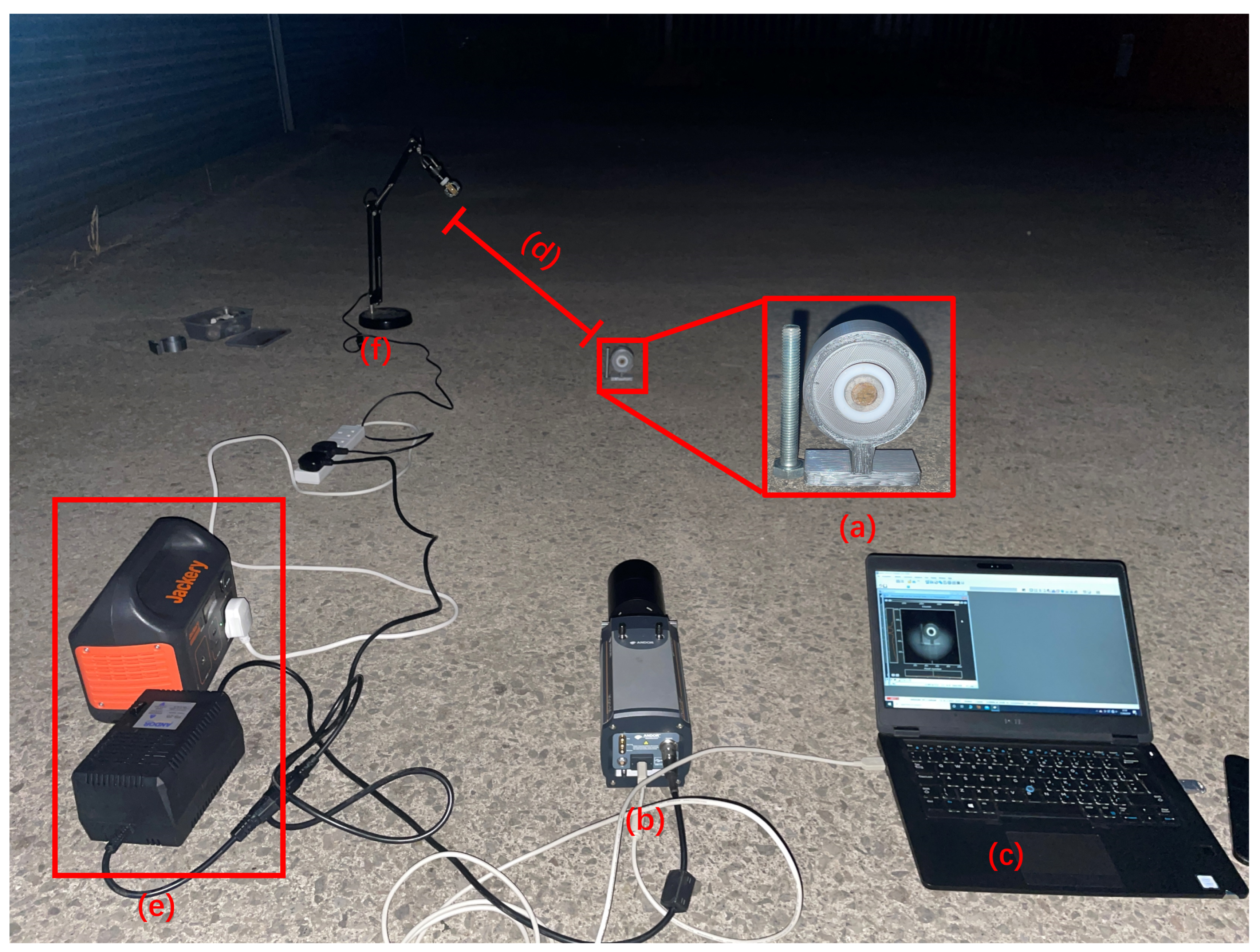

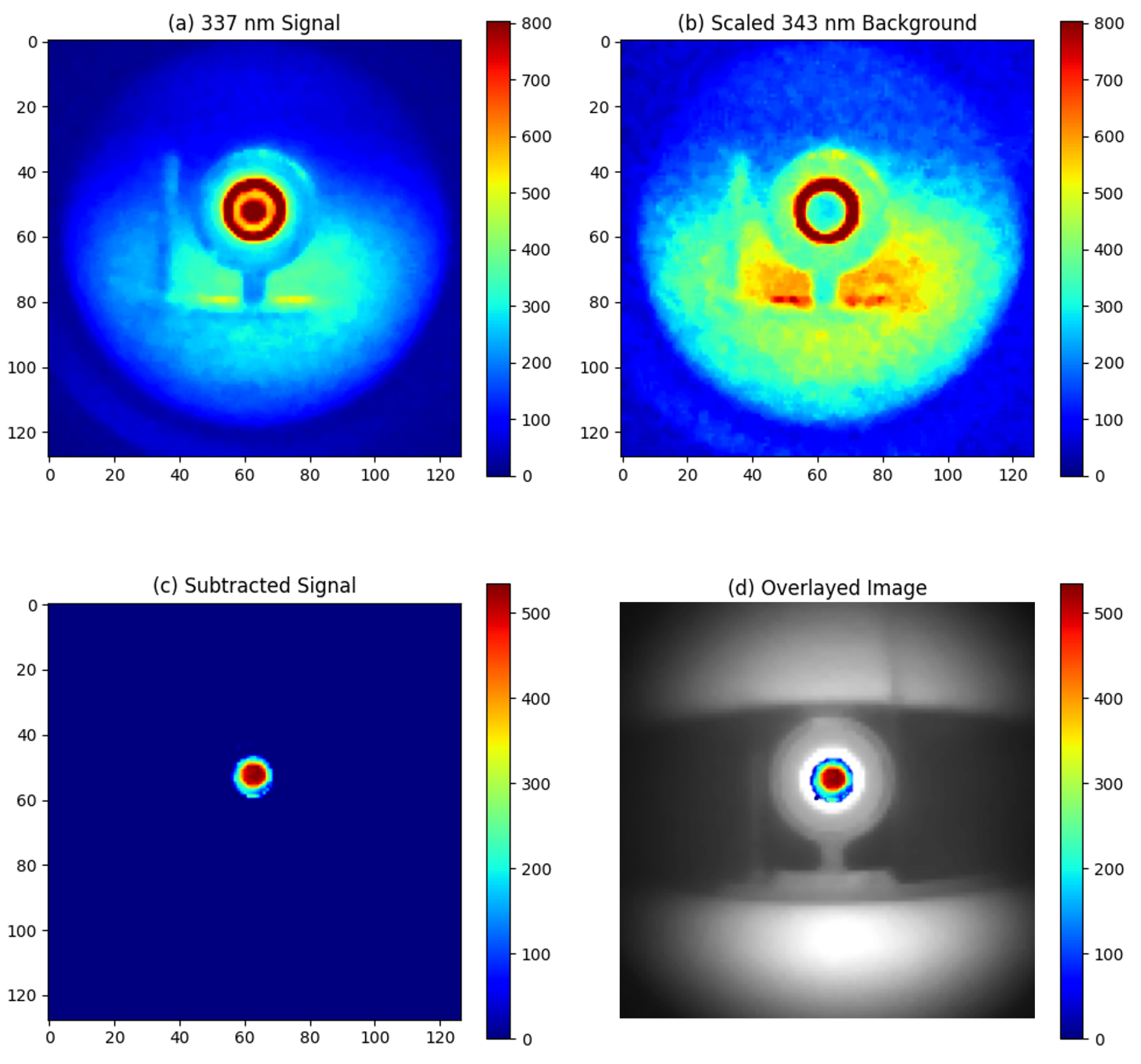
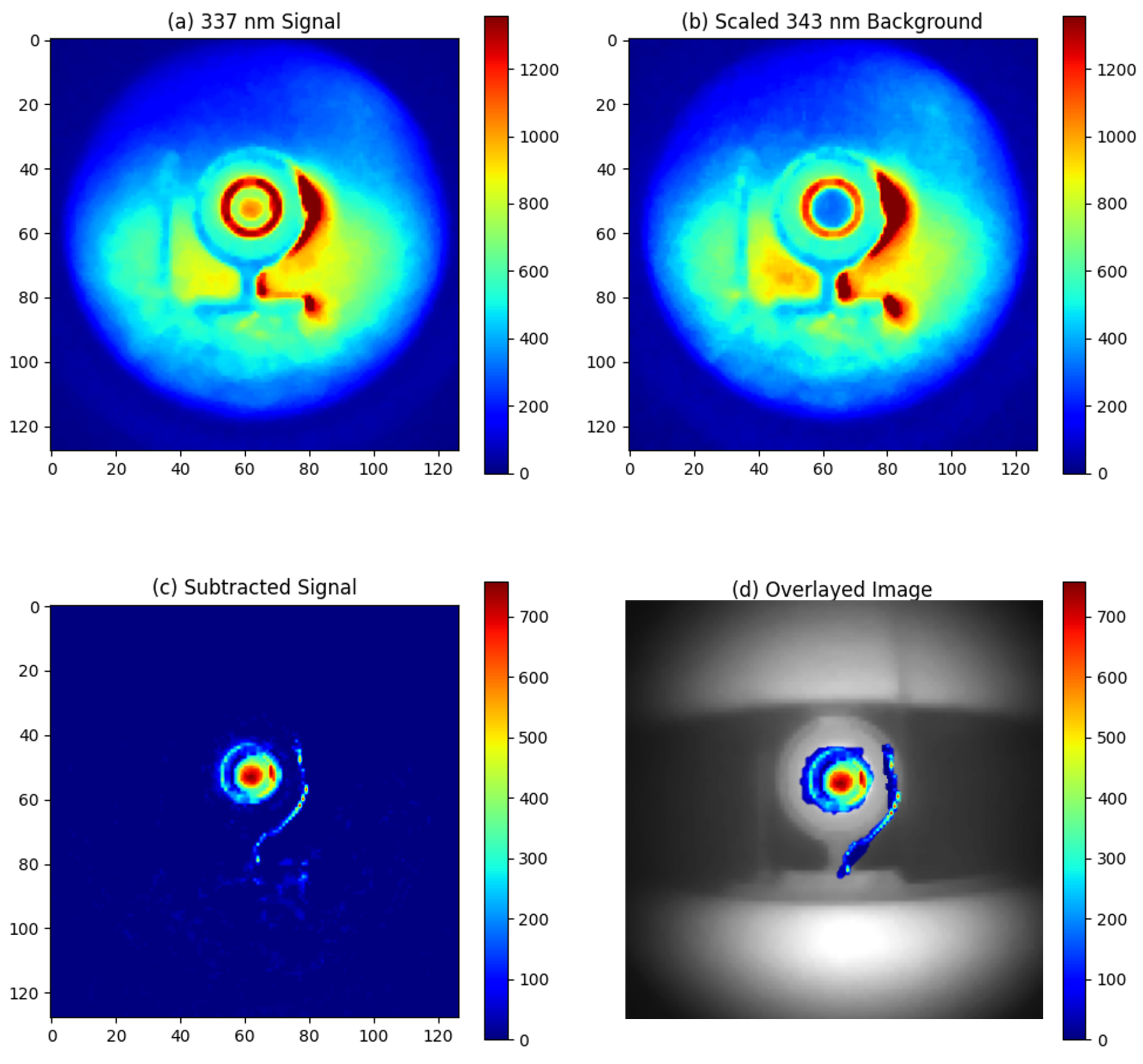

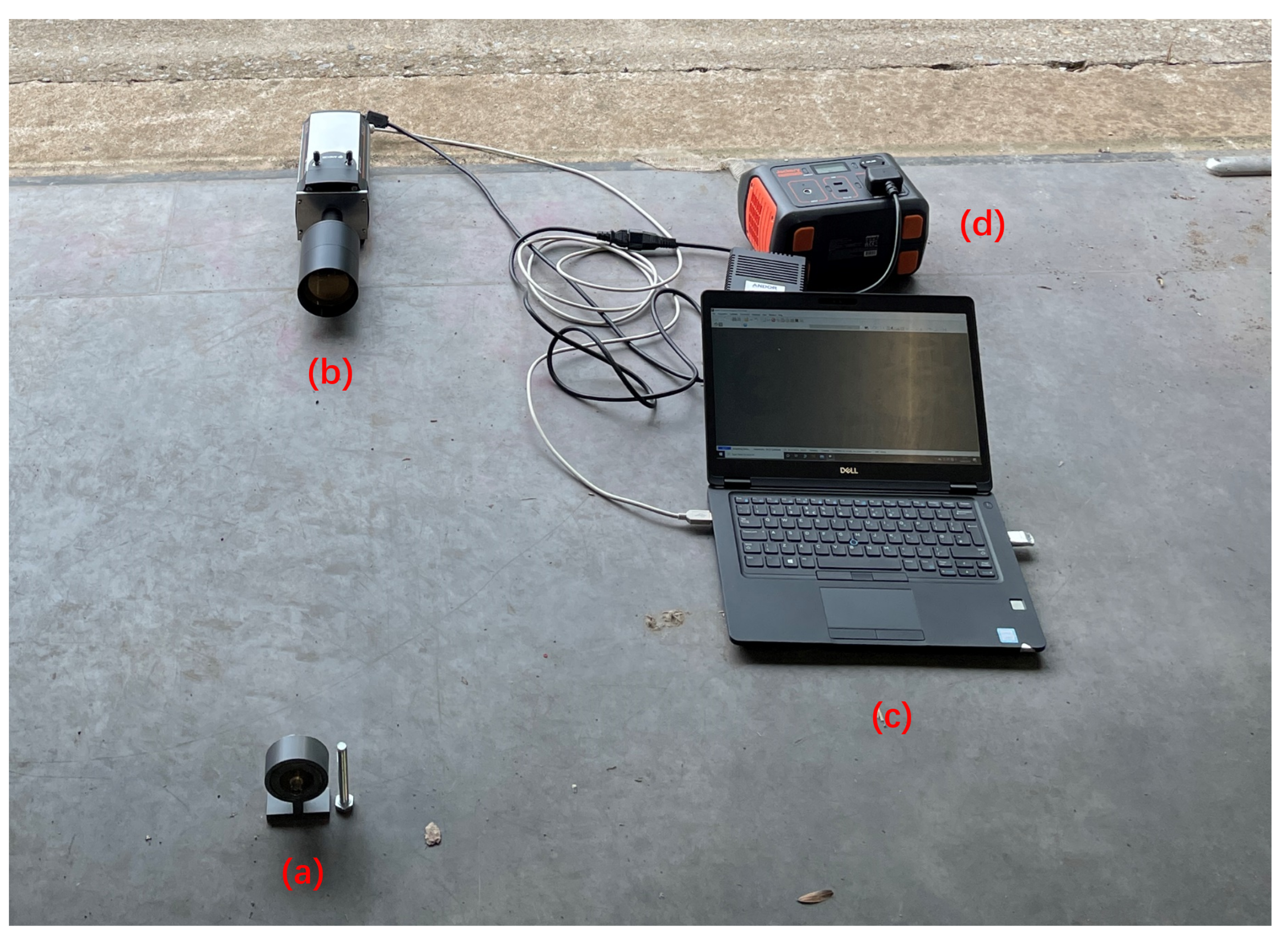

| Filter Name | Supplier | Specifications | Purpose |
|---|---|---|---|
| 65-128 | Edmund Optics, York, UK | Reflective filter, CWL: 337 nm, FWHM: 10 nm, OD: 4 | Used to detect alpha RL at 337 nm. |
| 39-343 | Edmund Optics, York, UK | Reflective filter, CWL: 343 nm, FWHM: 5 nm, OD: 4 | Employed to detect background radiation at 343 nm. |
| Hoya U340 | UQG Ltd., Cambridge, UK | Absorptive filter, bandpass: 275–375 nm | Served to reduce multi-reflection between reflective filters. |
| FF01-276/SP-25 | Laser 2000 Photonics, Cambridge, UK | Reflective filter, 276 nm short pass | Utilized to eliminate ambient sunlight interference. |
| FBH450-40 | Thorlabs Ltd., Lancaster, UK | Reflective filter, CWL: 450 nm, FWHM: 40 nm, OD: 5 | Captures images in the visible band to overlap with the alpha RL signal. |
| Lens Name | Supplier | Specifications |
|---|---|---|
| LA4372-UV | Thorlabs Ltd., Lancaster, UK | FL = 150.0 mm, Aperture = 75 mm |
| LC4513-UV | Thorlabs Ltd., Lancaster, UK | FL = −75.0 mm, Aperture = 25.4 mm |
| 21-912 | Edmund Optics, York, UK | FL = 25 mm, Aperture = 25 mm |
| Light Source | Supplier | Specifications |
|---|---|---|
| Fluorescent Light Tube | Megaman, Herts, UK | 20 watts, 1151 lumen |
| Incandescent Light Bulb | Leuci, Buckinghamshire, UK | 40 watts, 389 lumen |
| LED Light Bulb | Wilko, Bristol, UK | 4.4 watts, 470 lumen |
Disclaimer/Publisher’s Note: The statements, opinions and data contained in all publications are solely those of the individual author(s) and contributor(s) and not of MDPI and/or the editor(s). MDPI and/or the editor(s) disclaim responsibility for any injury to people or property resulting from any ideas, methods, instructions or products referred to in the content. |
© 2024 by the authors. Licensee MDPI, Basel, Switzerland. This article is an open access article distributed under the terms and conditions of the Creative Commons Attribution (CC BY) license (https://creativecommons.org/licenses/by/4.0/).
Share and Cite
Kong, L.; Scott, T.B.; Day, J.C.C.; Megson-Smith, D.A. Long-Range Imaging of Alpha Emitters Using Radioluminescence in Open Environments: Daytime and Night-Time Applications. Sensors 2024, 24, 5345. https://doi.org/10.3390/s24165345
Kong L, Scott TB, Day JCC, Megson-Smith DA. Long-Range Imaging of Alpha Emitters Using Radioluminescence in Open Environments: Daytime and Night-Time Applications. Sensors. 2024; 24(16):5345. https://doi.org/10.3390/s24165345
Chicago/Turabian StyleKong, Lingteng, Thomas Bligh Scott, John Charles Clifford Day, and David Andrew Megson-Smith. 2024. "Long-Range Imaging of Alpha Emitters Using Radioluminescence in Open Environments: Daytime and Night-Time Applications" Sensors 24, no. 16: 5345. https://doi.org/10.3390/s24165345
APA StyleKong, L., Scott, T. B., Day, J. C. C., & Megson-Smith, D. A. (2024). Long-Range Imaging of Alpha Emitters Using Radioluminescence in Open Environments: Daytime and Night-Time Applications. Sensors, 24(16), 5345. https://doi.org/10.3390/s24165345







